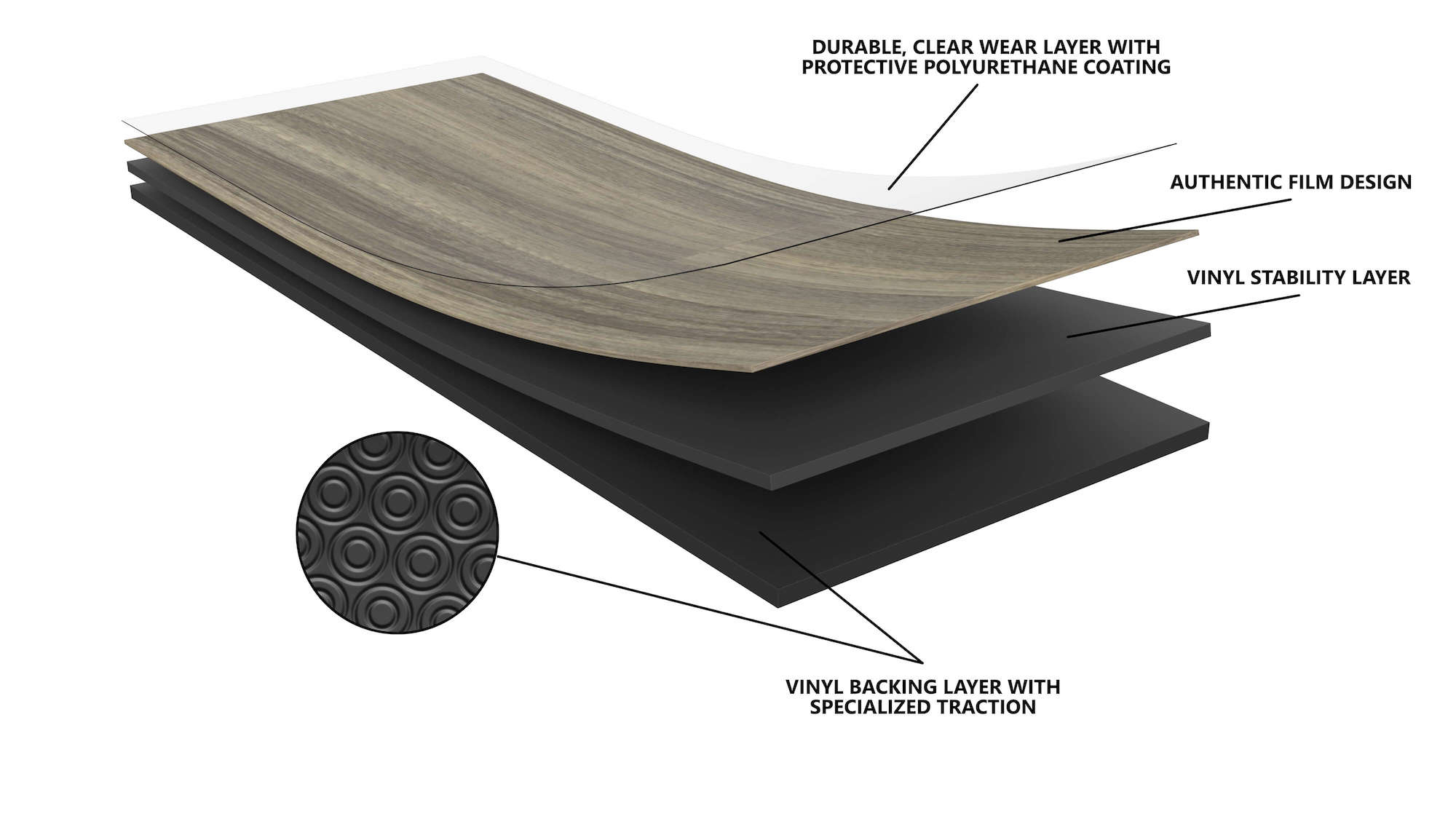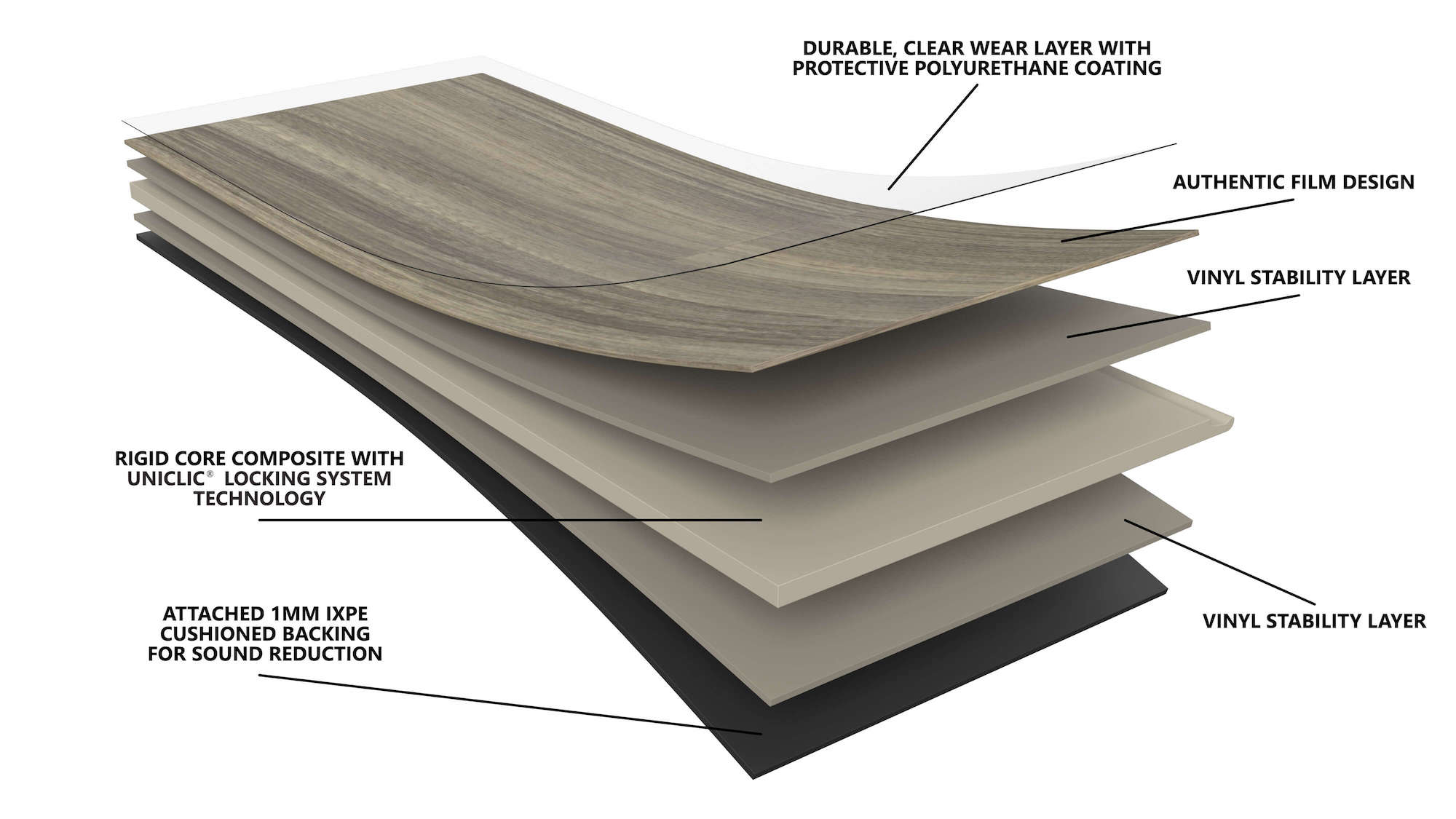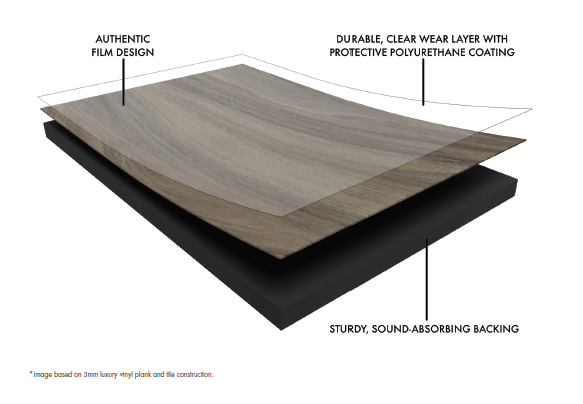Glue Down vs. Floating: Your Top Installation Choices for Luxury Vinyl Flooring
Selecting an LVT product to include in your next interior design project is as much about installation and application as it is about style and design aesthetics. After all, if the installation method you choose is not ideal for its intended application or environment – the look and feel of the flooring suffers and the beautiful vinyl floors you thought would last a long time could end up breaking down.
The good news is that, depending on the flooring you choose, you essentially have two choices on how to install your luxury vinyl flooring: glue down vs. floating. Driving your decision is the fact that each method features its own set of benefits that may make more sense depending upon your industry, the setting, and your overall approach to your interior design project.
To best illustrate the comparable characteristics of glue down vs. floating installation, let’s first explain how each method works:
What is Glue Down Vinyl Flooring?
The glue down installation method involves the use of an adhesive to adhere your dryback luxury vinyl flooring to its base. Using an adhesive creates dimensional stability that ensures the flooring maintains its natural characteristics. The glue down method involves two distinct types of adhesives: hard set and pressure sensitive.
- Hard Set — Similar to a broadloom carpet adhesive, a hard set adhesive spreads along the subfloor — which in turn holds the vinyl flooring firmly in place. This is especially important for environments within the healthcare or retail industries that experience heavy rolling traffic such as wheelchairs and gurneys or shopping carts and dollies. As a relatively new adhesive product to the luxury vinyl flooring market, hard set adhesive allows your glue down flooring to absorb a heavy point load, which means furniture and fixtures are far less likely to leave noticeable indentations when removed. Hard set is designed for sheet vinyl, but also works well with vinyl tile and plank.
- Pressure sensitive — As the longtime industry standard, pressure sensitive adhesive allows for an installation process that makes your flooring sturdy, yet easier to replace. Pressure sensitive adhesive is especially suited for the retail and hospitality industries, or those that tend to change up their brand on a continual basis. Pressure sensitive adhesive is ideal for vinyl tile and plank flooring.
| Hard Set | Pressure Sensitive |
| Adhesive is spread along the floor, then flooring is laid on top. | The flooring product itself has adhesive on it, and is bonded to the floor with pressure. |
Both the hard set and pressure sensitive adhesive approach involve similar installation techniques related to spread rate, which can usually be found in a flooring product’s adhesive or installation manual.
What is Floating Vinyl Flooring?
Derived from the laminate flooring business, the floating flooring category encompasses two different products with different installation options: loose lay vinyl and click vinyl flooring. Floating flooring was once the go-to installation strategy, roughly 10-15 years ago in the residential marketplace. This “floating” installation method remains a very popular choice today — especially for vinyl flooring.
Depending on the type of floating product, floating installations involve little to no adhesive that can either be installed directly over the subfloor, or using a cushion or vapor barrier system.
- Loose Lay Vinyl Flooring – Just as the name implies, loose lay flooring is loosely laid on top of the subfloor of a space. This floating flooring option makes for a quick install with beautiful results. Though installation instructions may vary depending on manufacturer or installer, typically loose lay flooring is installed by first gluing down planks or tiles around the perimeter of the space (for small areas) and applying adhesive in a grid formation (for larger areas; and then loosely laying the rest of the planks or tiles. When complete the planks or tiles will stay in place.

- Click Vinyl Flooring – Click vinyl flooring, comprised of rigid core click and click options, is a versatile plank and tile flooring option. To install click flooring, simply snap planks or tiles into place using the click-locking system integrated into the flooring product.

Rigid Core Click depicted *
| Loose Lay | Click |
| Vinyl flooring adhered to the edges of a subfloor, then additional planks and tiles are laid in place without an adhesive. | Vinyl flooring installed by “clicking” or snapping planks together across a subfloor. |
The reason floating vinyl flooring has regained popularity in recent years is due to advancements in how vinyl flooring is made and its ability to handle moisture. The floating approach is used in many scenarios where the flooring is being installed over an old adhesive left behind from an earlier flooring product — or anything involving residual asbestos.
Today, floating flooring has found a place within the commercial industry — most notably in multi-family housing developments.
Glue Down vs. Floating: What Are My Thickness Options?
- Glue Down vinyl flooring: Most popular is 2mm and 3mm varieties, but there are other thickness options available too.
- Loose Lay vinyl flooring: This floating option is typically sold in a 5mm thickness.
- Click vinyl flooring: The most popular version of click vinyl is rigid core click, which can come in a 5mm thickness with an added 1mm acoustic backing (though sometimes without).
| Glue Down | Loose Lay | Click |
| 2mm & 3mm | 5 mm | 6 mm (or 5mm) |
Glue Down vs. Floating: What Designs Are Available?
The appeal of any luxury vinyl product is the vast number of design choices at your disposal. LVT has been crafted to mirror the look of wood, stone, tile, concrete, and more, giving you beautiful design options with the durability of vinyl flooring.
Each installation method has many design choices to choose from, and the type of flooring you choose will likely impact your style options. Some notable color and style options from Parterre that are popular for each install method include:
- Glue Down: Keren Thread and Terrasse Oak
- Loose Lay: Moraine Walnut and Cumbria Beech
- Click (Rigid Core): Beckett Maple and Hampton Oak
Glue Down vs. Floating: Which Installation Method is Best for Commercial Spaces?
When deciding whether to use the glue down installation method or a floating floor for your next project, it’s important to consider how much foot traffic the area typically gets.
Generally, commercial spaces — like office spaces, restaurants or retail stores — experience heavier than normal foot traffic and therefore can benefit from vinyl flooring that is glued down (since the glue provides extra support in keeping the flooring in place). As mentioned earlier, healthcare is another industry that could benefit from the glue down method due to the heavy rolling traffic from wheelchairs or gurneys.
The option of installing floating floors, either loose lay vinyl or click vinyl flooring, is still practical for some commercial settings where foot traffic is not as heavy, as well as some residential settings.
In most cases, glue down flooring is covered by a commercial warranty, while floating flooring may be limited to only a light commercial and/or residential warranty. Whether working with glue down or floating flooring, it is recommended to consult with your manufacturer to confirm the product’s warranty.
Glue Down vs. Floating: Which is Easier to Replace?
One benefit of using the glue down approach with luxury vinyl plank and tile flooring is that it involves a seamless replacement — which again makes it an ideal method for the ever-changing retail or hospitality industry. With minimal effort, tiles or planks can be replaced one by one, if needed.
For floating installations, we find that loose lay flooring is also relatively easy to replace if needed. The same premise as glue down applies, as individual planks and tiles can be replaced relatively easily. For click flooring, however, replacement is a bit more involved because of its click locking system. The locking system involves installing the click vinyl flooring in a systematic manner — meaning you must essentially remove each row of flooring located before the section in need of replacement.
| Glue Down | Floating |
| Worn or damaged tiles can be removed and replaced individually, saving time and money. | Same as glue down, except click flooring, which requires removal of multiple planks or tiles for repairs. |
Glue Down vs. Floating: Which is Easier to Clean/Maintain?
Both flooring installation methods involve similar cleaning and maintenance approaches that are simple and easy to follow. For most vinyl products, click, loose lay, or adhesive, a traditional two-bucket system and regular sweeping has proven to be an effective way to clean the flooring. However, it is always recommended to refer to the manufacturer’s maintenance manual and instructions for best practices.
Glue Down vs. Floating: What Should I Know About the Subfloor?
The subfloor of your installation is an important consideration when choosing a type of flooring and an installation method. When it comes to types of subfloor, glue down, loose lay, click, or floating flooring, each was created equal. Not one flooring format type works best for one type of subfloor.
However, all flooring types typically work well with concrete subfloors, though there are various factors that need to be taken into consideration. Always consider the moisture levels of the subfloor and the exposure your new flooring will have to moisture. Also make note if this is a renovation or new build project, as that will impact flooring choices.
Glue Down vs. Floating: What About Acoustics?
Acoustical value should play at least a small part in your vinyl flooring installation decision. This is because the sound your flooring gives off has a lot to do with the way it is fastened to the subfloor. It is also important to keep in mind that the acoustics within a space are not solely based on the flooring you choose; they are also dependent on the subfloor preparations and furnishings selected for the space.

First, luxury vinyl flooring, whether glue down or floating, is generally quieter underfoot than most hard surfaces. With a floating flooring installation, the product is not actually attached to the subfloor, meaning it may give off a hollower sound compared to that of the glue down method—though the thicker a product, the quieter it tends to be. And with certain floating floor options, especially rigid core click, some manufacturers offer added acoustic backings to help with sound reduction.
Contact us today to learn more about ideas on how to best install your vinyl flooring product.
Note: Prior to performing any of the techniques listed above, refer to your flooring manufacturer’s technical manual.
Parterre Flooring
Read MorePolished Concrete vs. Vinyl Flooring
Polished Concrete vs. Vinyl Flooring Polished concrete vs. vinyl flooring. It’s not an easy decision, considering both provide an excellent solution for commercial flooring. The look of concrete floors has been a growing trend for commercial interiors.
Chevron and Herringbone
Break the Pattern of Commercial Flooring You can add more flair to your commercial flooring by breaking from the look of traditional straight-line, square, and diagonal patterns. Eye-catching looks like chevron and herringbone will dot the designer landscape in 2024.